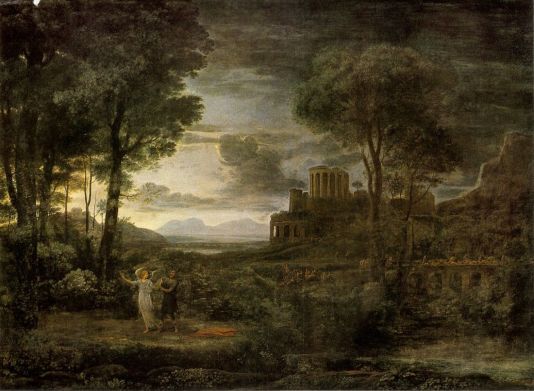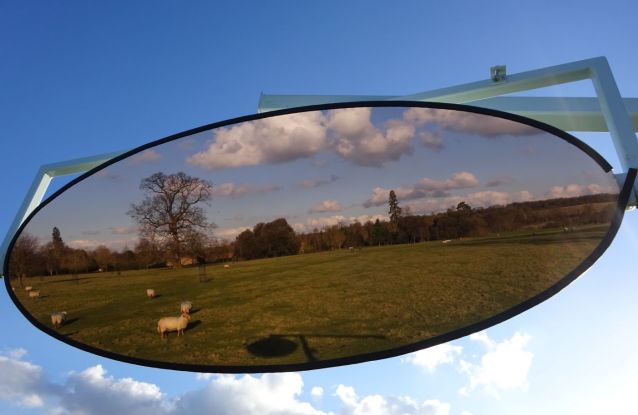(Or how to make your own 17th Century selfie app)
There’s a new art installation at Wimpole Hall celebrating the tercentenary of Capability Brown’s birth this year. It takes the form of a series of large-scale easels marching across the park. Each easel is composed of a Claude mirror* and they come in different shapes, are tinted in different colours and have different landscape emphasis. The idea is to get people to pause and consider the view of the landscape through CB’s eyes and maybe do a spot of painting, photography etc., while having a bit of fun.
Here is one at the top of the hill situated to show the lakes and folly:

*Claude mirrors (or glasses) were portable drawing aids, popular in the 18th and 19th centuries, which were used by landscape artists and tourists to frame a view. They were typically hand-sized, often sepia or brown-tinted, convex mirrors. Using such a mirror to look at the landscape you would see a distorted (fish-eye) perspective and compressed saturation and tonal values. This resulted in a reflection looking like the much admired landscapes of 17th Century painter Claude Lorrain, hence the name.

Sunrise by Claude Lorrain
Claude Lorrain was a french artist, working mostly in Italy, whose baroque paintings were appreciated for their classical landscapes and subtle gradation of tones. The landscapes were often staged to include gods and heroes, i.e. many were works of pure theatre. Claude particularly liked to paint scenes at dusk or dawn, comprised of mellow colours, pink-tinged clouds and dark foregrounds.

Night by Claude Lorrain
A century later Lancelot ‘Capability’ Brown was similarly creating idealised landscapes in the estates around the country. Wimpole was one of them and so the ‘Scene: A new way of looking’ art installation, combining the notions of both these great men, was born.

Evoking the English countryside …. you might remember these sheep from Wednesday’s post

This Claude mirror is positioned to follow the fosse and Ha-ha (which of course you don’t see ha ha)
Anyway, having seen some of the easels I thought that I might like a Claude mirror for myself, but nobody sells them these days, so I resorted to making one. In fact there are already online instructions showing how you might do this.
The first hurdle to overcome was finding some appropriately sized convex glass. You have to think outside the box a bit to get hold of bubble glass, but I found an old alarm clock face did the trick. Then I sprayed the back of the glass with black paint (to approximate a dark tint). I think black is slightly extreme, but it was a first model. Once the paint dried I took the mirror outside and was suitably impressed with the moody reflection seen in the glass.

When I had a walk around the park at Wimpole to see the installations I took my Claude mirror with me too. It was an interesting experiment. The mirrors on the easels had clearly better tints and brighter images, but I liked the convexed view in my hand-held one too.

However, the major downside of the fisheye view is the unavoidable inclusion of the mirror holder in any scene.
Yes, it looks like this is the equivalent of a 17th century selfie app.

Or maybe I am just the goddess or heroine in this picture!
#sceneatwimpole

A great post! These mirrors are so amusing. It is interesting to learn how the old masters used mirrors and different kind of optic to create their masterpieces. Have you ever read about Hockney- Falco research? It is simply amazing.
Thanks for that info. It is an interesting study. I used to do radio astonomy and spent a lot of my PhD removing instrument artifacts from the images/maps I was making! I never considered that paintings might show the same effects.
I have seen camera obscura and camera lucida in work. There is some discrepancy in scale, as in any modern photograph, but the details are amazing.
Aren’t you clever! A great take away from the exhibition. Maybe you can set it up somewhere and use a long lens to capture a scene with less of you in the photo, but I like the idea of you being the goddess in the scene! 🙂
Good thinking, but I think that what I really need is a less convexed glass lens. Someone mentioned barometer glass, however, without being able to tint the glass better, I am reluctant to pursue it
What an interesting thing to do. I will look into this further as a means of creating atmospheric photographs.
I’d be interested to hear of any ideas!
I love the mirrors. And ha ha. Such a beautifully British term. I think I first learned that word in one of Jane Austin’s books, though I can’t remember which one.
Definitely the right period. There are so many odd words relating to architecture and landscape features.
Pretty fascinating. Thanks for describing this so well.
Thanks. It was very interesting to find out about them.
Fascinating! I’d never heard of these before — what a marvelous idea!
Yes, it is interesting to think of artists sitting with their backs to their subject. How strange must that feel?